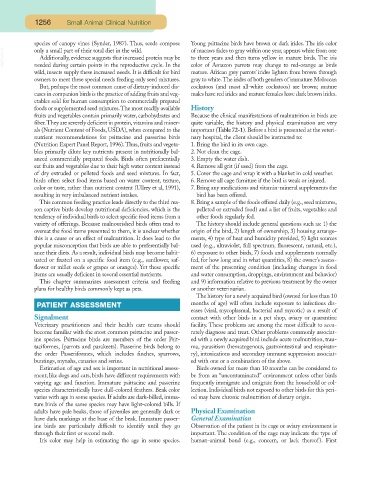Page 1206 - Small Animal Clinical Nutrition 5th Edition
P. 1206
1256 Small Animal Clinical Nutrition
species of canopy vines (Synder, 1987). Thus, seeds compose Young psittacine birds have brown or dark irides. The iris color
VetBooks.ir only a small part of their total diet in the wild. of macaws fades to gray within one year, appears white from one
to three years and then turns yellow in mature birds. The iris
Additionally, evidence suggests that increased protein may be
color of Amazon parrots may change to red-orange as birds
needed during certain points in the reproductive cycle. In the
wild, insects supply these increased needs. It is difficult for bird mature. African grey parrots’ irides lighten from brown through
owners to meet these special needs feeding only seed mixtures. gray to white.The irides of both genders of immature Moloccan
But, perhaps the most common cause of dietary-induced dis- cockatoos (and most all-white cockatoos) are brown; mature
eases in companion birds is the practice of adding fruits and veg- males have red irides and mature females have dark brown irides.
etables sold for human consumption to commercially prepared
foods or supplemented seed mixtures.The most readily available History
fruits and vegetables contain primarily water, carbohydrates and Because the clinical manifestations of malnutrition in birds are
fiber.They are severely deficient in protein, vitamins and miner- quite variable, the history and physical examination are very
als (Nutrient Content of Foods, USDA), when compared to the important (Table 72-1). Before a bird is presented at the veteri-
nutrient recommendations for psittacine and passerine birds nary hospital, the client should be instructed to:
(Nutrition Expert Panel Report, 1996).Thus, fruits and vegeta- 1. Bring the bird in its own cage.
bles primarily dilute key nutrients present in nutritionally bal- 2. Not clean the cage.
anced commercially prepared foods. Birds often preferentially 3. Empty the water dish.
eat fruits and vegetables due to their high water content instead 4. Remove all grit (if used) from the cage.
of dry extruded or pelleted foods and seed mixtures. In fact, 5. Cover the cage and wrap it with a blanket in cold weather.
birds often select food items based on water content, texture, 6. Remove all cage furniture if the bird is weak or injured.
color or taste, rather than nutrient content (Ullrey et al, 1991), 7. Bring any medications and vitamin-mineral supplements the
resulting in very imbalanced nutrient intakes. bird has been offered.
This common feeding practice leads directly to the third rea- 8. Bring a sample of the foods offered daily (e.g., seed mixtures,
son captive birds develop nutritional deficiencies, which is the pelleted or extruded food) and a list of fruits, vegetables and
tendency of individual birds to select specific food items from a other foods regularly fed.
variety of offerings. Because malnourished birds often tend to The history should include general questions such as: 1) the
overeat the food items presented to them, it is unclear whether origin of the bird, 2) length of ownership, 3) housing arrange-
this is a cause or an effect of malnutrition. It does lead to the ments, 4) type of heat and humidity provided, 5) light sources
popular misconception that birds are able to preferentially bal- used (e.g., ultraviolet, full spectrum, fluorescent, natural, etc.),
ance their diets. As a result, individual birds may become habit- 6) exposure to other birds, 7) foods and supplements normally
uated or fixated on a specific food item (e.g., sunflower, saf- fed, for how long and in what quantities, 8) the owner’s assess-
flower or millet seeds or grapes or oranges). Yet these specific ment of the presenting condition (including changes in food
items are usually deficient in several essential nutrients. and water consumption, droppings, environment and behavior)
This chapter summarizes assessment criteria and feeding and 9) information relative to previous treatment by the owner
plans for healthy birds commonly kept as pets. or another veterinarian.
The history for a newly acquired bird (owned for less than 10
PATIENT ASSESSMENT months of age) will often include exposure to infectious dis-
eases (viral, mycoplasmal, bacterial and mycotic) as a result of
Signalment contact with other birds in a pet shop, aviary or quarantine
Veterinary practitioners and their health care teams should facility. These problems are among the most difficult to accu-
become familiar with the most common psittacine and passer- rately diagnose and treat. Other problems commonly associat-
ine species. Psittacine birds are members of the order Psit- ed with a newly acquired bird include acute malnutrition, trau-
taciformes, (parrots and parakeets). Passerine birds belong to ma, parasitism (hematogenous, gastrointestinal and respirato-
the order Passeriformes, which includes finches, sparrows, ry), intoxications and secondary immune suppression associat-
buntings, mynahs, canaries and serins. ed with one or a combination of the above.
Estimation of age and sex is important in nutritional assess- Birds owned for more than 10 months can be considered to
ment; like dogs and cats, birds have different requirements with be from an “uncontaminated” environment unless other birds
varying age and function. Immature psittacine and passerine frequently immigrate and emigrate from the household or col-
species characteristically have dull-colored feathers. Beak color lection. Individual birds not exposed to other birds for this peri-
varies with age in some species. If adults are dark-billed, imma- od may have chronic malnutrition of dietary origin.
ture birds of the same species may have light-colored bills. If
adults have pale beaks, those of juveniles are generally dark or Physical Examination
have dark markings at the base of the beak. Immature passer- General Examination
ine birds are particularly difficult to identify until they go Observation of the patient in its cage or aviary environment is
through their first or second molt. important. The condition of the cage may indicate the type of
Iris color may help in estimating the age in some species. human-animal bond (e.g., concern, or lack thereof). First

